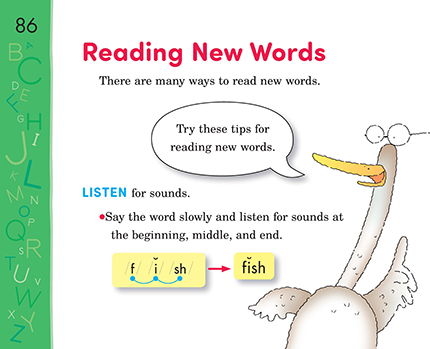Page 86 from

Start-Up Activity
Read and discuss pages 86–87, which give strategies for reading new words. Then help students understand consonant blends (page 88), consonant diagraphs (page 89), long vowels (page 90), short vowels (page 91), rhyming families (pages 92–93), contractions (page 94), and compound words (page 95). Help students use what they learn when they encounter new words in their reading.
Enrichment Activity: Give students wide-spaced graph paper and have them write a word horizontally with a letter in each cell. Then have them write another word vertically, making it share one of the letters of the first word. Have them continue this way, crossing words horizontally and vertically until they can't think of other words to cross. Then tell them to fill in the other spaces with random letters. Afterward, ask students to share their word-find puzzles with other students, who will try to solve them.
Think About It
“Learning how to read words is just a starting point.”

Start-Up Activity
Read and discuss pages 86–87, which give strategies for reading new words. Then help students understand consonant blends (page 88), consonant diagraphs (page 89), long vowels (page 90), short vowels (page 91), rhyming families (pages 92–93), contractions (page 94), and compound words (page 95). Help students use what they learn when they encounter new words in their reading.
Enrichment Activity: Give students wide-spaced graph paper and have them write a word horizontally with a letter in each cell. Then have them write another word vertically, making it share one of the letters of the first word. Have them continue this way, crossing words horizontally and vertically until they can't think of other words to cross. Then tell them to fill in the other spaces with random letters. Afterward, ask students to share their word-find puzzles with other students, who will try to solve them.
Think About It
“Learning how to read words is just a starting point.”